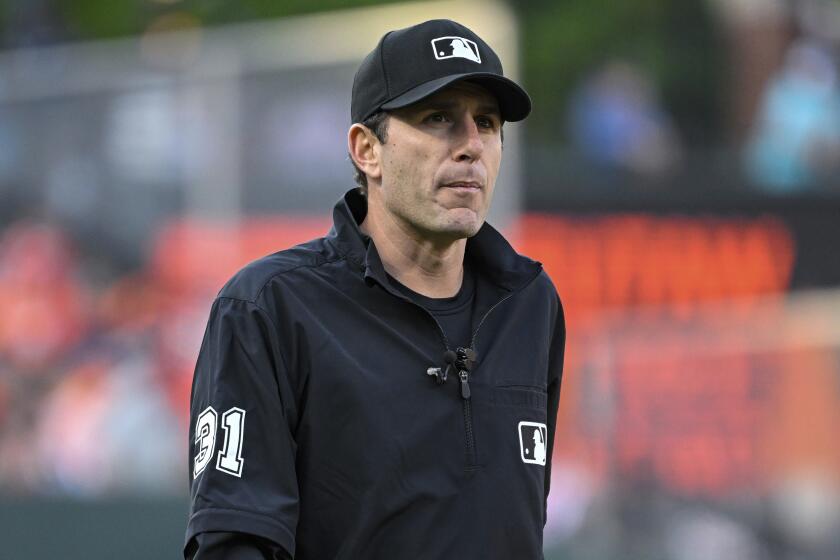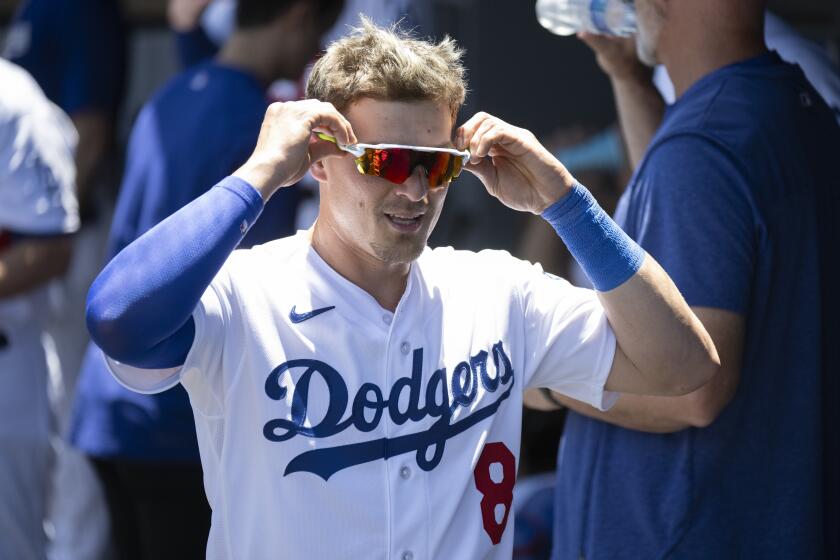ANALYSIS : Dodger Tradition Goes Only So Far
- Share via
After delivering a sentimental speech about Dodger pride two months ago in Philadelphia, Fred Claire was walking out of the clubhouse when a player noticed he had forgotten his pen.
The player picked it up and threw it to him.
Claire snatched the pen out of the air, then paused.
“Caught it,” he announced.
Amid much nervous laughter, Claire had also caught the essence of the 1992 Dodgers.
After motivating with the words of Branch Rickey and Walter Alston, the vice president used a writing implement to show his team something about defense.
This season has not been about Jose Offerman’s arm, Darryl Strawberry’s back and more than one error per evening.
This season has been about tradition. By desperately clinging to a tradition, the Dodgers have made a mockery of it.
From the Boys of Summer to the Stuntmen of 1988, this franchise has often won for no apparent reason other than that they were the Dodgers.
In the past several years, the game and its personalities have changed drastically. But a front-office attitude borne of success had not.
Management has still treated the Dodger uniform as if it were made of magic. As if it could heal the sick and soothe the troubled.
Spending more than four months in last place this summer has taught them otherwise.
The uniform could not make Jay Howell sound, or Juan Samuel younger or Kal Daniels care.
It could not coat Mike Scioscia like armor. It could not make Eric Davis play safer. It could not make Jeff Hamilton play harder.
And the uniform, no matter how good it looks on him, could not make Darryl Strawberry a leader.
Even Blue Heaven, if not properly maintained and updated, can become hell.
Now the Dodgers know.
Only one Dodger team in this century has finished in last place, the 1905 Brooklyn Dodgers, who were 48-104.
Soon there probably will be two.
The 1992 Dodgers are not merely a last-place team. They are considered by veteran scouts to be one of the worst teams in the National League in the last 25 years.
And to think that last season, they spent 131 days in first place.
Steering the franchise into this crash have been Claire and associates, who are often out of touch with the clubhouse and sometimes out of touch with reality.
Their problems began with Strawberry.
His back injury is often listed as the biggest cause for their skid, but the team was 18-23 when Strawberry was starting. And the Dodgers were only 11-18 when Strawberry and Davis started together.
The problem is not Strawberry’s back, it is the club’s apparent misconception of his personality.
From the first day of spring training this season, he was placed in the role of clubhouse leader. With several high-profile veterans missing, the Dodgers needed him to perform the role that Kirk Gibson played so well in 1988.
Darryl Strawberry is no Kirk Gibson.
Strawberry is one of the most talented pressure players in the game. Nobody should attempt to change him.
But nobody should expect him to be an example, either.
The last time a Dodger game really meant something, Strawberry didn’t even bother warming up.
After taking the chilly field without benefit of batting practice or proper stretches, he took a called third strike in the first inning. He struck out with a runner on second base in the ninth inning.
In between, he hit two weak fly balls and missed a cutoff man from right field, costing the Dodgers a run.
It was Oct. 5, 1991. When the game at Candlestick Park ended, the San Francisco Giants had defeated the Dodgers, 4-0, giving the Atlanta Braves the National League West championship.
It should have been apparent then that if Strawberry was supposed to be this team’s foundation, it had no foundation.
This spring Strawberry took the field late, distracted teammates with news conferences about his book and generally caused confusion that only a Strawberry can endure.
Some young teammates followed his example, and quiet clubhouse divisions occurred.
Next spring the pressure will be on him again.
Teammates openly wondered why he delayed back surgery recommended by one of the country’s most renowned back specialists, Dr. Robert Watkins.
If Strawberry misses one regular-season game in 1993 because of the delay, fingers will be pointed.
Once he recovers, the Dodgers should have another everyday player around to help run the show. Maybe Eric Karros will be ready. The Dodgers should hope so.
They should treat Strawberry as he was treated by the 1986 New York Mets--not as a cornerstone, but as a colorful decoration.
If the Dodgers can’t do that, they should trade him.
And you thought this season’s troubles centered around Jose Offerman.
Indeed, his fifth-row throws epitomized their misery. When this team is awarded its place in history, Offerman will be remembered as its symbol. But he was not its biggest problem.
The Dodgers had to give this former minor league player of the year a chance. And even a league-high 40 errors should not dissuade them from allowing him to grow next year.
The team is most worried about his incredible lapses of concentration. But a good second baseman who is not afraid to embarrass him can cure that in a week.
The worst thing about Offerman was that, like Strawberry, he was given the wrong role. He should have been the start of a rebuilding effort instead of a plug in a raft nobody realized was sinking.
He should have been surrounded with more players on their way up, instead of down.
But last winter, all Claire could see was that one game that separated his team and the Braves. His only concerns were eliminating that one game.
“Looking back, maybe our agenda was too busy. Maybe we tried to do too much,” Claire acknowledged. “We were definitely affected by the fact that we finished just one game out the previous season.”
Claire was affected so much that:
--He traded away the organization’s top reliever prospect--John Wetteland--along with Tim Belcher for a veteran with a history of injury.
Davis, who could have been the leader Strawberry wasn’t, lived up to that history.
And Wetteland has 35 saves for the Montreal Expos, more than all the Dodger relievers combined.
Don’t blame Kevin Kennedy, former manager at triple-A Albuquerque and now a coach with the Expos. He said he turned in positive reports on Wetteland for five years.
--Claire figured Jay Howell, at age 36, could recover from arm injuries to become the team’s bullpen stopper.
Howell did not pitch until May 22. That forced Roger McDowell, acquired last season to be a setup man, into the uncomfortable role of stopper.
During various times of the season, every other reliever also pitched out of position.
--Claire counted on second baseman Juan Samuel to stabilize Offerman and the middle of the infield.
Claire overlooked his uniformed personnel’s dislike of Samuel’s range and wild swing. He overlooked an anger that had festered in Samuel after being refused a multi-year contract for consecutive seasons.
About two weeks into spring, Samuel said he wanted to be traded because he didn’t feel wanted.
Soon enough, he wasn’t wanted. The Dodgers still haven’t found an everyday second baseman.
--Claire believed Kal Daniels loved playing for the Dodgers so much he would gladly change positions and ignore the pain in his legs, even when there were spring whispers that Daniels didn’t like first base.
Even when it was obvious that he could not pull a ball anymore because of his surgically scarred knees, management didn’t listen.
When Daniels was traded to the Chicago Cubs for prospects June 27, he had cost the Dodgers most of $2.5 million.
--Claire stood alone in the organization in thinking Jeff Hamilton could solve their problems at third base.
When Hamilton was waived this spring and returned to Albuquerque, it effectively ended a romance that cost the Dodgers a chance at signing the league’s 1991 most valuable player.
Terry Pendleton wanted to sign with the Dodgers as a free agent two years ago. But his agent was told by somebody in the front office that third base belonged to you-know-who.
Today, third base belongs to who-knows-who?
Claire, who was executive of the year in 1988, cannot be blamed for everything.
He did not know Scioscia would finally show the effects of years of contact. He did not know that middle reliever Steve Wilson would lose his touch.
He did not know that starting pitcher Ramon Martinez would have days when he looked like an old Fernando Valenzuela.
Claire also did much that worked.
He let Eddie Murray leave, allowing Karros to become the likely rookie of the year. He let Mike Morgan leave, which allowed Kevin Gross to become the team’s most valuable pitcher.
Most important, Claire seems to have learned from this season. He appears ready for a winter quite unlike the last.
Complacent veterans will be shipped out. More youngsters will be brought in. There will be no attempt at a high-priced quick fix.
The 1993 Dodgers might not win a championship, but unlike this year’s team, they could be fun. Because they could know where they are going.
“We are at a far different stage this winter than last winter, even more different than the standings show,” Claire said. “We definitely need to take a longer-term view of the club. Will free agency answer our major needs? No. If anything, what is required is more patience.”
The starting pitching will be left intact. Claire will acquire a bullpen stopper--perhaps even Pedro Astacio will be moved there.
Two infielders will be added somehow, while trade might be made for a good young left fielder.
Mike Piazza, Karros and Offerman should round out an opening day lineup in which half the team could have three years of experience or less.
Tom Lasorda, who was never really a factor this season because of his depleted lineup, could have an exciting final season in uniform. That is, if he stays.
After all, the Dodgers are now no different than anybody else.
More to Read
Are you a true-blue fan?
Get our Dodgers Dugout newsletter for insights, news and much more.
You may occasionally receive promotional content from the Los Angeles Times.









